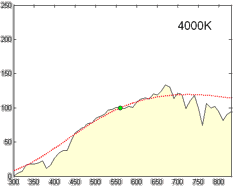D65光源
D65光源︵D65こうげん︶、CIE標準光源D65 ︵CIEひょうじゅんこうげんD65、D65とも記載[1][2]︶ は、国際照明委員会 ︵CIE︶ により定義された標準光源である[3] 。Dシリーズとして定義されている光源の一つであり、屋外の照明環境を再現することを目的に定義されている。

D65の分光分布。
D65は、欧州/北欧における平均的な正午の光 ︵直射日光と晴天の空による拡散光の合わさった光︶ に対応しており、昼光光源とも呼ばれている。 標準光源は波長ごとの平均スペクトルとして定義されているので、統計的に同じ相対分光分布を持つ光源は、D65光源であるとみなすことができる。実際のD65光源というのは存在せず、D65光源をシミュレートする疑似光源しか存在しない。光源の精度はCIE条件等色指数で評価される[4][5]。
CIEはD65光源を標準昼光光源として以下のように位置づけしている:
[D65]は平均的な昼光を表現することを目的としており、その相関色温度はおよそ6500Kである。CIE標準光源D65は、光源について特段の指定がない限り、すべての昼光下におけるカラリメトリー計算に用いることができる。特に紫外線領域において、季節や時間、地理学的位置によって、昼光の相対分光分布が変動することが知られている。

—ISO 10526:1999/CIE S005/E-1998、CIE Standard Illuminants for Colorimetry

経緯
編集定義
編集
D65は、300 nm ~ 830 nmの間における、5 nm間隔の分光分布からなるテーブルで定義されており、もともと10 nm間隔で定義されていたデータを線形補間したものが使われている[9][10] 。CIEは、線形補間により分光分布の成分間の補間をすることを推奨しているが、スプライン補間の利用の提案もなされている[11]。
CIE1931色空間の色度座標において、D65は
 と定義される ︵CIE 1931 2°測色標準観察者︶。
相対輝度 ︵すなわち、Y = 100︶ の正規化は、XYZの三刺激値を用いて
と定義される ︵CIE 1931 2°測色標準観察者︶。
相対輝度 ︵すなわち、Y = 100︶ の正規化は、XYZの三刺激値を用いて
 CIE 1964 10°測色標準観察者において、
CIE 1964 10°測色標準観察者において、
 D65は白色光を表すため、その座標も白色点であり、対応する相関色温度は6504Kである。HDTVに使われているRec. 709では、CIE 1931座標においてx=0.3127、y=0.329に丸められている。
D65は白色光を表すため、その座標も白色点であり、対応する相関色温度は6504Kである。HDTVに使われているRec. 709では、CIE 1931座標においてx=0.3127、y=0.329に丸められている。
 と定義される ︵CIE 1931 2°測色標準観察者︶。
相対輝度 ︵すなわち、Y = 100︶ の正規化は、XYZの三刺激値を用いて
と定義される ︵CIE 1931 2°測色標準観察者︶。
相対輝度 ︵すなわち、Y = 100︶ の正規化は、XYZの三刺激値を用いて
 CIE 1964 10°測色標準観察者において、
CIE 1964 10°測色標準観察者において、
 D65は白色光を表すため、その座標も白色点であり、対応する相関色温度は6504Kである。HDTVに使われているRec. 709では、CIE 1931座標においてx=0.3127、y=0.329に丸められている。
D65は白色光を表すため、その座標も白色点であり、対応する相関色温度は6504Kである。HDTVに使われているRec. 709では、CIE 1931座標においてx=0.3127、y=0.329に丸められている。
なぜ6504Kなのか?
編集脚注
編集出典
編集- ^ Noboru, Ohta; Robertson, Alan R. (2005). “3.9: Standard and Supplementary Illuminants”. Colorimetry. Wiley. pp. 92–96. doi:10.1002/0470094745.ch3. ISBN 0-470-09472-9
- ^ Poynton, Charles A. (2003). Digital Video and HDTV: Algorithms and Interfaces. Morgan Kaufmann. p. 224. ISBN 1-55860-792-7. "The CIE D illuminants are properly denoted with a two-digit subscript."
- ^ Schanda, János (2007). “3. CIE Colorimetry”. Colorimetry: Understanding the CIE System. Wiley. pp. 43, 44. doi:10.1002/9780470175637.ch3. ISBN 978-0-470-04904-4. "In 1967 the International Practical Temperature Scale, 1948, amended 1960 was in use. With that temperature scale c2 was 1.438×10−2m·K. In 1968, the International Practical Temperature Scale changed the value of c2 to 1.4388×10−2 m·K. Because of this fact the CCT of a daylight phase of T K on the 1948/1960 scale changed to 1.4388/1.4380×T, thus D65 with its ‘‘nominal CCT’’ has now a CCT of approximately 6504 K, and this temperature has to be set into the Equations (3.17) and (3.18) to get to the SPD as defined in 1967."
- ^ CIE Technical Report (1999). A Method for Assessing the Quality of Daylight Simulators for Colorimetry. Paris: Bureau central de la CIE. ISBN 92-9034-051-7. "A method is provided for evaluating the suitability of a test source as a simulator of CIE Standard Illuminants D55, D65, or D75. The Supplement, prepared in 1999, adds the CIE Illuminant D50 to the line of illuminants where the method can be applied to. For each of these standard illuminants, spectral radiance factor data are supplied for five pairs of nonfluorescent samples that are metameric matches. The colorimetric differences of the five pairs are computed for the test illuminant; the average of these differences is taken as the visible range metamerism index and is used as a measure of the quality of the test illuminant as a simulator for nonfluorescent samples. For fluorescent samples, the quality is further assessed in terms of an ultraviolet range metamerism index, defined as the average of the colorimetric differences computed with the test illuminant for three further pairs of samples, each pair consisting of a fluorescent and a nonfluorescent sample which are metameric under the standard illuminant."
- ^ Lam, Yuk-Ming (August 2002). “Evaluation of the quality of different D65 simulators for visual assessment”. Color Research & Application 27 (4): 243–251. doi:10.1002/col.10061.
- ^ Judd, Deane B. (August 1964). “Spectral Distribution of Typical Daylight as a Function of Correlated Color Temperature” (abstract). JOSA 54 (8): 1031–1040. doi:10.1364/JOSA.54.001031.
- ^ Wyszecki, Günter (February 1968). “Recent Agreements Reached by the Colorimetry Committee of the Commission Internationale de l'Eclairage” (abstract). JOSA 58 (2): 290–292.
- ^ Committee E-1.3.1 (Colorimetry) (19–28 June 1967). Proceedings of the 16th session. Washington, D.C. Paris: CIE.
- ^ CIE.
- ^ Relative SPD of D65, 300–830nm in 1nm increments.
- ^ Kránicz, Balázs (August 2000). “Re-evaluation of daylight spectral distributions”. Color Research & Application 25 (4): 250–259. doi:10.1002/1520-6378(200008)25:4<250::AID-COL5>3.0.CO;2-D.

